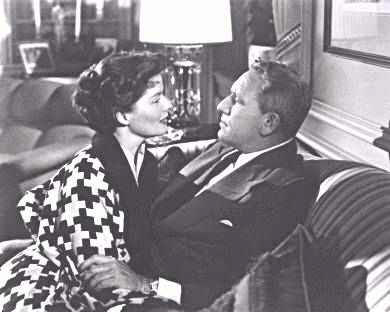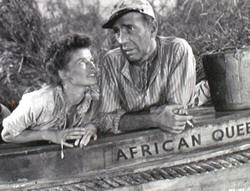In Remembrance: Katharine Hepburn
 Katherine Hepburn, whose cool intelligence and feisty independence made her
a leading Hollywood actress, passed away June 29, 2003. Hepburn, who had
been in declining health in recent years, died of old age at her home in Old
Saybrook, CT and was surrounded by her family. She was 96.
Katherine Hepburn, whose cool intelligence and feisty independence made her
a leading Hollywood actress, passed away June 29, 2003. Hepburn, who had
been in declining health in recent years, died of old age at her home in Old
Saybrook, CT and was surrounded by her family. She was 96.
Born May 12, 1907 in Hartford, CT, Hepburn was the daughter of a doctor and a suffragette. She graduated in 1928 from Bryn Mawr College outside of Philadelphia with a degree in drama. After graduating, she began getting small roles on Broadway. It was her starring role as an Amazon princess in A Warrior’s Husband in 1932 that brought her a movie role offer from RKO.
Hepburn went to Hollywood and after a few screen tests, she was cast opposite John Barrymore in the 1932 George Cukor film A Bill Of Divorcement. The film was a hit and RKO signed her to a full contract. Her third film, Morning Glory (1933), brought her her first Academy Award for her convincing role as a starstruck Broadway ingenue. That same year she teamed with Cukor again, starring as Jo March in the now classic version of Louisa May Alcott’s novel Little Women.
Despite her success on screen, Hepburn’s unconventional behavior off-screen began to create a rift between her and the general public. This may have contributed to a box office slump the actress experienced from 1935 to 1938, even with a performance in Alice Adams (1935), which brought her a second Academy Award nomination.
Once thought of as a flop but now considered one of the greatest comedy classics, Hepburn put the screwball in screwball comedy with her performance in Bringing Up Baby (1938), directed by Howard Hawks and co-starring Cary Grant.
Although a theatre owner had labeled her “box office poison,” Hepburn decided that she wanted to return to Broadway. She acquired the rights to a comedy about a spoiled heiress; having it rewritten for her, The Philadelphia Story became a hit. About this time Hepburn was also considered a leading contender to play Scarlet O’Hara in David O. Selznick’s upcoming production of Gone With The Wind, but studio execs rejected her, still unsure of her box-office star quality.
MGM wanted Joan Crawford to star in a film version of The Philadelphia Story, until it was discovered the Hepburn and Howard Hawks co-owned the film rights. Hepburn had approval over the cast and requested Cary Grant be cast opposite her given their chemistry in Bringing Up Baby. The film was a box-office hit. Hepburn reignited her stalled career, becoming a credible star and earning her third Oscar nomination.
 Hepburn soon became linked to some of the great men of Hollywood including
directors John Ford and Howard Hawks. But in 1942 she met the one man who
would become the great love of her life when she was paired with Spencer
Tracy on Woman Of The Year. Their chemistry on screen lasted for
eight more films over 25 years; it was a romance that lasted even longer off
screen. Hepburn would also receive her fourth Oscar nomination for Woman
Of The Year.
Hepburn soon became linked to some of the great men of Hollywood including
directors John Ford and Howard Hawks. But in 1942 she met the one man who
would become the great love of her life when she was paired with Spencer
Tracy on Woman Of The Year. Their chemistry on screen lasted for
eight more films over 25 years; it was a romance that lasted even longer off
screen. Hepburn would also receive her fourth Oscar nomination for Woman
Of The Year.
One Hepburn and Tracy’s best pairings was Adam’s Rib (1949) directed by George Cukor. The pair’s work defined the battle-of-the-sexes comedies, with such films as Pat and Mike (1952), also directed by Cukor, and 1957’s Desk Set.
 By 1950 Hepburn was at the height of her popularity. Perfecting the role of
spinster through the 1950s, Hepburn earned four more Oscar nominations for
her roles in The African Queen (1951), Summertime (1955),
The Rainmaker (1956) and Suddenly, Last Summer (1959).
By 1950 Hepburn was at the height of her popularity. Perfecting the role of
spinster through the 1950s, Hepburn earned four more Oscar nominations for
her roles in The African Queen (1951), Summertime (1955),
The Rainmaker (1956) and Suddenly, Last Summer (1959).
Hepburn continued to deliver strong, serious performances into the 1960s even though her screen appearances dwindled. Her riveting performance as the morphine-addicted mother in Sydney Lumet’s 1962 adaptation of Long Day’s Journey Into Night earned her another Academy Award nomination. After a five-year absence she starred in Guess Who’s Coming To Dinner, he last collaboration with Spencer Tracy, who died three weeks after filming wrapped. The film earned Hepburn her second Oscar win. She won her third Oscar the following for her role as Eleanor of Aquitaine in The Lion In Winter opposite Peter O’Toole.
As Hepburn’s movie roles lessened, she gave more time to the stage, appearing in Shaw’s The Millionaires and Shakespeare’s As You Like It. She would win Tony Awards for Coco (1969) and West Side Waltz.
In the 70s, she starred in the made-for-TV movies The Glass Menagerie (1973) and The Corn Is Green (1978). She appeared with John Wayne in 1975’s feature film Rooster Cogburn, but the sequel to Wayne’s True Grit was a flop. Hepburn’s last Academy Award nomination and win was for her performance opposite Henry Fonda in the 1981 drama On Golden Pond. He last on screen appearance was in 1994’s Love Affair with Annette Bening and Warren Beatty.
With her health in decline, Hepburn wrote her autobiography Me in 1991 and then slowly retired from public life. Hepburn’s work has been widely recognized for its quality. She led all actresses on the American Film Institute’s June 2002 list of 100 Greatest Love Stories, with six films placing. She was also ranked as the #1 actress on the AFI’s list of 100 Greatest Film Legends. She still reigns as the only four time Oscar winner for acting and she held the title for most nominations until Meryl Streep was nominated for her 13th time in 2003.
-John Gibbon